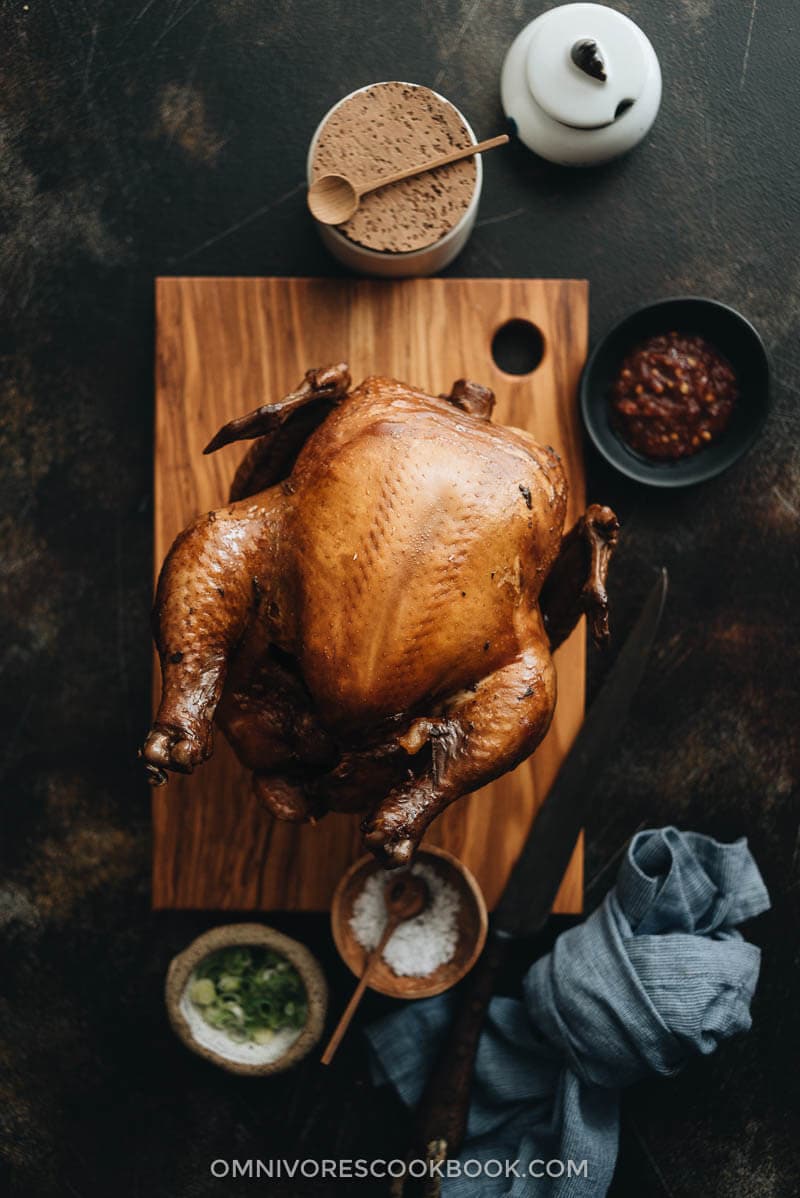
Cold sliced soy sauce chicken is definitely a Chinese dim sum classic. Along with crispy duck, char siu BBQ pork, and crispy pork belly, it’s one of those dishes that we order most often whenever we visit a Cantonese dim sum restaurant.
Dealing with a whole chicken might seem like a daunting task. But once you try the recipe, you’ll find out it’s quite straightforward. All you need to do is to mix the marinade, soak the chicken overnight, then simmer until the chicken is just cooked.
The finished chicken has such a tender, silky texture and a deep savory taste with a hint of sweetness. Served with hot steamed rice and extra sauce, I can’t stop eating even when I’m full!
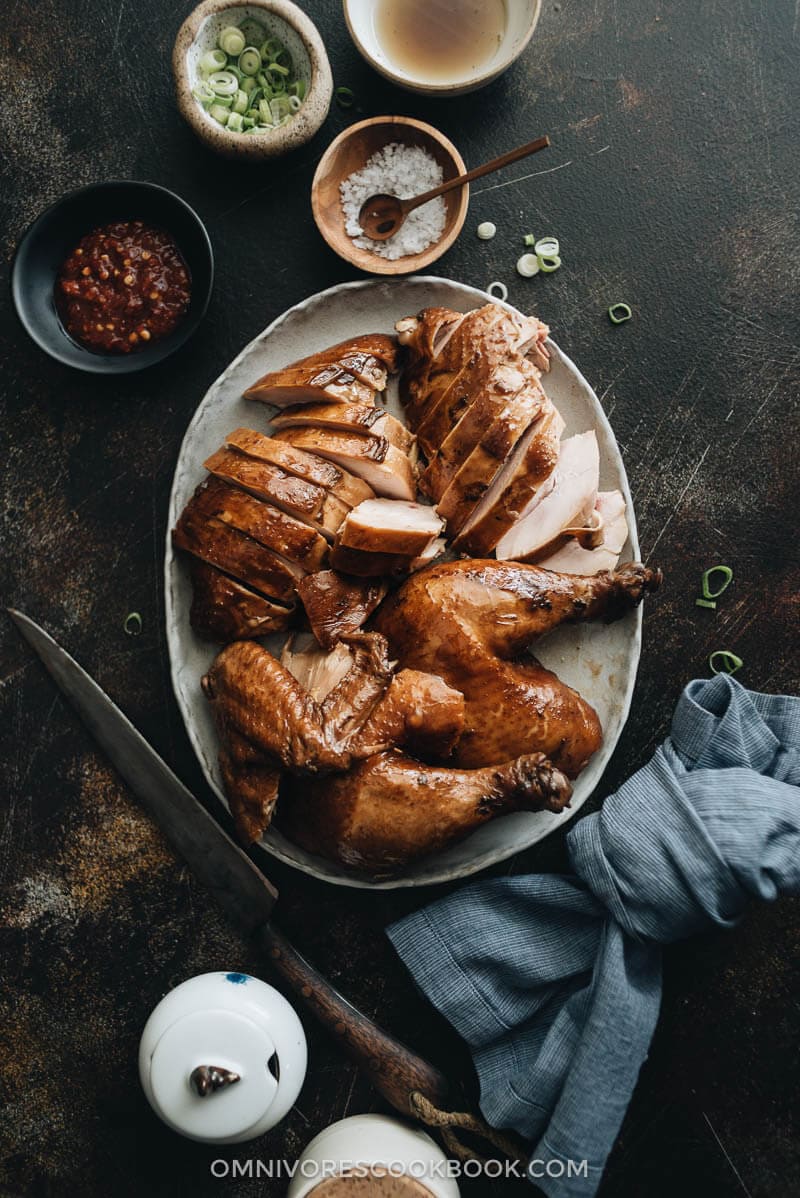
How to make the best soy sauce chicken
1. How to choose the right chicken
If you ask any Chinese chef, they’ll always recommend a young cage-free chicken that weighs less than 2 pounds. Because the smaller the chicken, the more the seasonings penetrate and the tenderer it will taste after simmering. That’s why if you browse a Chinese recipe site, most recipes won’t suggest marinating the chicken beforehand and include merely 15 minutes to cook the whole bird through!
In reality, it’s not that easy to find a chicken of such small size in the US. Plus, I prefer to cook some more meat to have some leftovers, since it takes quite some time to prep all the seasonings.
I prefer to use a smaller sized chicken, one that weighs 3 to 4 pounds. You can use a bigger bird as well. But note, it will take longer to cook through and it might not taste as tender.
2. Marinating is a must
Like I just mentioned above, many Chinese recipes do not include a marinating process, or they utilize a very brief marinating time. When dealing with larger chickens, marinating overnight is highly recommended, so your chicken will end up super flavorful.
The marinade ingredient list might look long, but you can probably find most, if not all, of them already sitting in your kitchen cupboard.
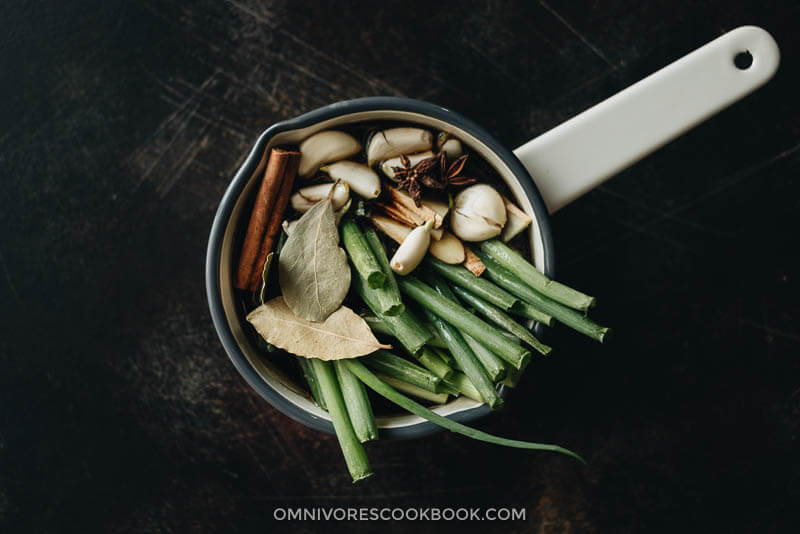
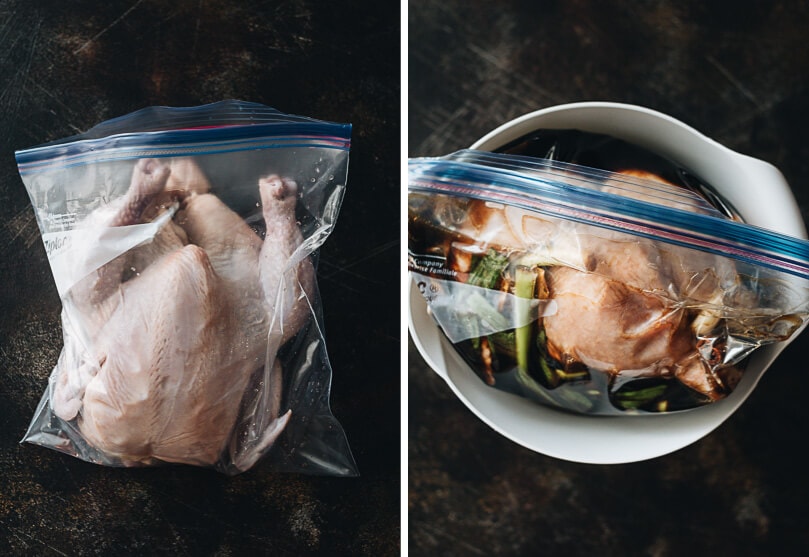
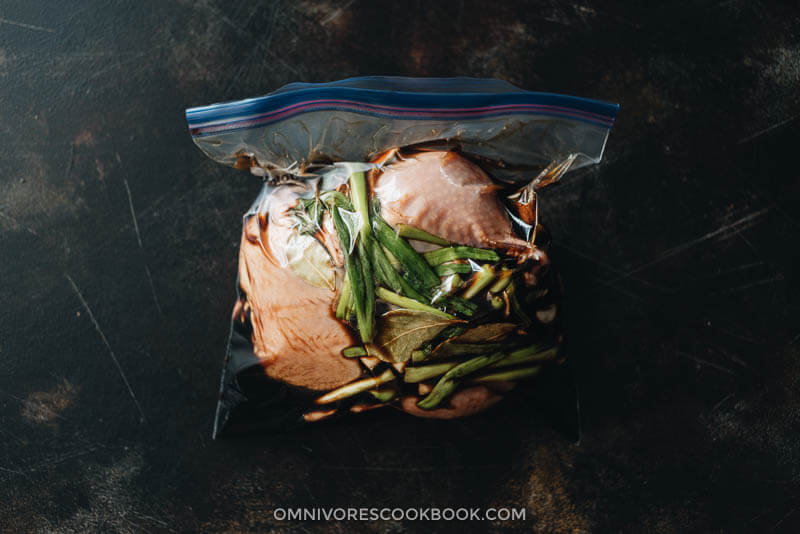
3. Choose the right pot
You should use a small, tall pot that is just wide enough to hold the chicken and can hold all the liquid. I often use a tall saucepan.
If you have to use a bigger pot, you’ll need to add enough water so at least half of the chicken is covered. In this case, place the chicken breast-side-down at first. Cook 15 minutes and then flip it so the chicken breast faces up.
4. Simmer, gently
The only time you should bring the broth to a boil is at the very beginning. Then you should always keep the broth at a simmer, where there are small bubbles raising to the top of the broth here and there. The very gentle simmer will produce buttery tender chicken without overcooking it. After 20 minutes, I’ll turn off heat and let the pot sit on the hot stove for another 30 minutes, so the chicken will be just fully cooked.
Deciding the right cooking time is tricky, since it can vary a lot depending on the size of the chicken and the type of stove you use. Just keep in mind that you should always keep the simmering very gentle, and check on the chicken every 15 to 20 minutes. You should cook until the thickest part of the thigh is just cooked through, to yield the best texture.
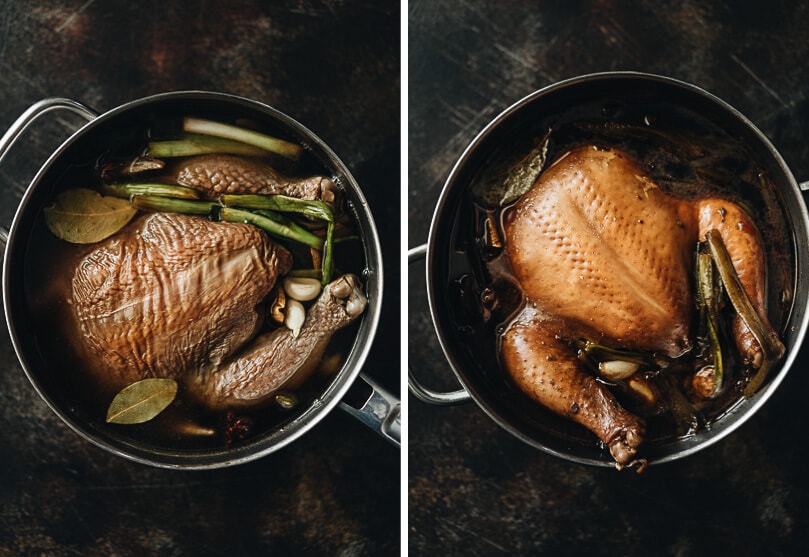
5. Slice and serve
Chinese restaurants always use a cleaver to chop the chicken into pieces and serve it bone-in. To make it easier for home cooks, I chose to carve it using a chef’s knife. I would carve the chicken into legs, breasts and wings. Then I’ll slice the parts I plan to serve and save the rest in a container.
The chicken tastes great warm and cold. I always reserve some braising liquid as dipping sauce and pour some on the steamed rice. You can also serve it with some Sriracha sauce.
If you don’t like the texture of the soft chicken skin, you can crisp up the skin under the broiler. But to speak the truth, I never feel like I need that extra step, despite the fact that I LOVE crispy chicken skin. The soy sauce chicken tastes perfect the way it is 🙂
I hope you enjoy the dish as much as I do!
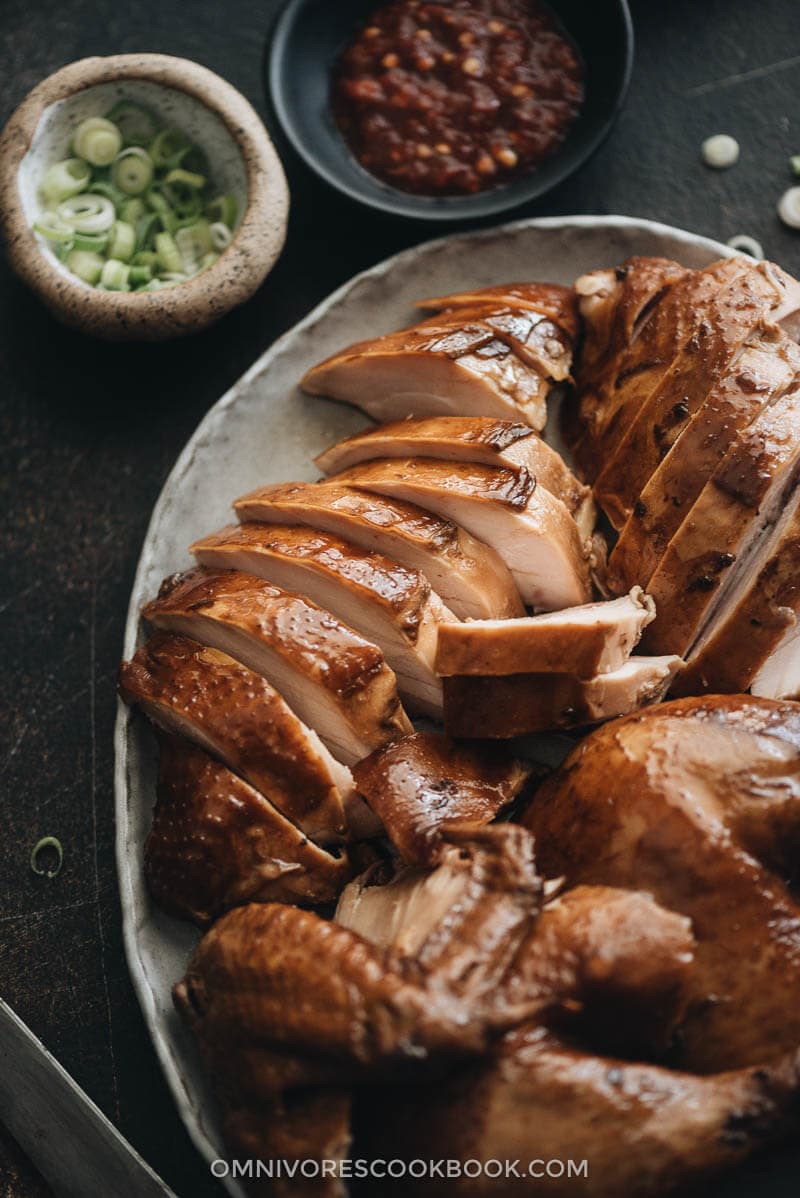
More delicious dim sum dishes
- Char Siu BBQ Pork
- Crispy Pork Belly
- Pork and Shrimp Shumai
- Steamed Ribs in Black Bean Sauce
- Cantonese Wonton Noodle Soup
- Chinese Broccoli with Oyster Sauce
If you give this recipe a try, let us know! Leave a comment, rate it (once you’ve tried it), and take a picture and tag it @omnivorescookbook on Instagram! I’d love to see what you come up with.
Chinese Cooking Made Easy
Are you new to this website? This free email series is a great place to start. I’ll walk you through a few of my most popular recipes and show you how and why they work. You’ll quickly start to cook better Chinese food in your own kitchen.
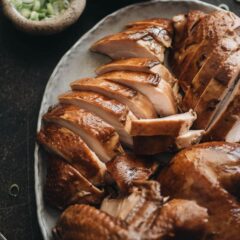
Real-Deal Soy Sauce Chicken (豉油鸡, See Yao Gai)
Ingredients
- 1 4 lbs / 1.8 kg whole chicken
Marinade
- 2 cups soy sauce
- 2 tablespoons dark soy sauce (Optional)
- 1/2 cup Shaoxing wine (or dry sherry)
- 2 tablespoons sesame oil
- 1 cup brown sugar (or granulated sugar)
- 1 big thumb ginger , coarsely chopped
- 8 cloves garlic , smashed
- 6 green onions
- 3 bay leaves
- 1 star anise pod
- 1 small cinnamon stick
- 1/2 teaspoon fennel seeds
- 2 cloves
Instructions
- Combine all the marinade ingredients in a medium-sized saucepan. Bring to a simmer. Stir and cook until the sugar dissolves. Set aside to cool.
- Place the chicken in a gallon-size ziplock bag. Carefully pour the cooled marinade mixture into the bag with all the ingredients. Seal the bag and squeeze out as much as air possible. Massage the bag a few times to evenly distribute the marinade. Place the bag in a large deep bowl so it “pushes” the marinade to fully cover the chicken. Plus the marinade won’t cause a mess if your bag accidently leaks. You can marinate the chicken in a large bowl, too. In this case, you might need to flip the chicken 2 to 3 times during the marinating process. Cover with a plastic bag if using a bowl. Let marinate overnight.
- Chose a pot that is deep and just wide enough to hold the chicken. Add the chicken into the pot, breast-side-up. Pour in all the marinade with the ingredients. If the chicken is not covered, add up to 4 cups water. It’s OK if a small part of the chicken breast is not covered in the liquid.
- Bring to a boil over medium high heat. Turn to medium-low or low heat. Use a fine mesh strainer to skim the foam and discard. When the broth reduces to a simmer, cover the pot. Simmer for 25 minutes. Turn off the heat. Let the chicken sit in the hot broth, covered, for another 30 minutes, or until the chicken is just cooked. To test, you can either insert a thermometer into the thickest part of the thigh or slice the skin that attaches the thigh to the body: the root of the thigh should no longer be pink. Soak the chicken in the broth, covered, if the chicken is not cooked. If the chicken is still very raw, return the pot to a simmer and cook until the chicken is fully cooked.
- Once done, carefully transfer the chicken onto a big plate and drain all the liquid from the cavity. I usually do this wearing one oven mitt with a few layers of paper towel, with the other hand using a pair of tongs. Let the chicken cool enough to handle with your hands. Carve the chicken and slice the parts you plan to serve. Reserve the liquid to use as dipping sauce, or for braising (try using it to braise daikon radish or potato - so delicious!).
- Serve the chicken warm with rice as a main or as a cold appetizer with Sriracha dipping sauce and extra sauce on the side. Enjoy!
Nutrition

Did you make this recipe?
I’d love to hear how it turned out for you! Please take a moment to leave a 5-star rating ⭐️ and share your thoughts in the comments further down the page. It really helps others discover the recipe too.


Sierra
Really excited to try this recipe! We don’t have any authentic Chinese places around and I’ve missed soy sauce chicken! Some places serve the chicken cold with a ginger sauce that is really good, but I am clueless on how to make the ginger sauce. Do you have any good recipes for that? (Or even know what I’m talking about? Maybe I am mixing up dishes)
Maggie Zhu
I love to serve the chicken with a bit sweet soy sauce mixed with regular soy sauce. And some hot sauce (chili garlic sauce or sriracha).
I think I know the ginger sauce you’re talking about. The base should be rice vinegar (or white vinegar) with grated ginger, a very small touch of garlic, pinch of salt and some sugar to balance it out.
Depending on the restaurant sometimes it has minced cilantro mixed in it, but it’s not a must. Don’t have a recipe now but I’ll look into it.
Errol
This Dish was so nice Maggie.The sauces were so delicious as had the other night.Thank you Maggie.
Sam
We just had this for dinner tonight and it was AWESOME! I loved the overnight marinating step, such a good idea that imparts so much flavor into this chicken.
I made some minor changes: 1) pan fried all the aromatics before boiling up the sauce 2) I used palm sugar 3) I used 1.5 cups of soy sauce and 1 tbs of sesame oil 4) 1/2 tsp of cinnamon powder instead of a stick 5)no fennel seeds.
My chicken was close to 5lb and it fit snugly into my 4 qt pot. I was able to marinate and cook the chicken in that pot, and only needed to add 2 cups of water.
I plan to make this for future family gatherings. Thank you for such a fantastic recipe!
Maxwell
I’ve been researching this recipe and have read or watched about 15 instructions. Yours is the first to advise marinating – Kudos. I don’t see how you can get enough infused flavor without marinating. My only objection, if you can even call it that, is you are not frying the aromatics in the beginning, just pouring sauce in pot to heat. I don’t have your experience, but would like to know if you think frying the aromatics is a waste of time and effort? This is pretty traditional in Chinese cooking.
Maggie Zhu
Frying aromatics definitely help building flavor more, although many traditional Chinese recipes boil the spices directly when it comes to braising. In this case, I think you can definitely fry the aromatics.
Actually the traditional recipe usually does not include marinating I think. the trick is to use super young and small chicken that has a very thin layer of meat (very hard to come by in the US), so you can infuse quite a bit flavor during the cooking. Plus, since it’s a street / restaurant dish, the chicken is usually left in the broth after cooking so it gets marinated more. For home cooking, I found marinating first will get you the most flavor using a regular size chicken.
Bridget K
Had a whole chicken to cook for dinner and came across your recipe. So doable compared to the many Si Yau Kai (soy chicken) recipes I scrolled through – no honey!
I only used 1/2 cup sugar as one cup seems a lot (also only had castor sugar in the house) but everything else according to the recipe. Marinated for about three hours. The method of cooking is similar to one of my favorite hainanese chicken rice recipe(chicken goes into boiling water, 30 minutes simmering and 30 minutes rest), so I know the chicken will be tender when done.
The thighs were not fully submerged (despite 4 cups of water)so I suspected they could be undercooked. I was right but that was easily rectified by submerging the thighs again in the simmering liquid. Overall the chicken turned out so yummy and the meat was so tender. Slightly salty, probably due to the reduced amount of sugar.
Will certainly give it another go 😋. Thanks Maggie for the lovely detailed recipe and helpful hints
Angela Wong
Hi Maggie,
I tried this recipe and the sauce was delicious. I had a smaller near 2 lbs chicken so I took one of the other comments you made to reduce the cooking to 10-15 mins. I went to 15 mins but let the chicken sit in the sauce for 30 mins after turning off the heat. The chicken was a bit drier than I would have liked and the internal temperature was 170. I’d really like to try this again because the taste was fantastic but wanted to ask whether you’d recommend reducing the cooking time or the sit in the pot time. What would you recommend?
BTW, the sauce is so good, we saved it to marinate eggs. Mm
Maggie
I think you should definitely reduce the sitting in the pot time because it’s a bit harder to control. It’s the best to monitor the temperature and take out the chicken as soon as the temperature of the thickest part of the thigh reaches 165 F.
I’m glad to hear you like the sauce! You can use it as a noodle sauce as well. It’s really good drizzle with a bit chili oil 🙂
Barbara OConnor
When I was a kid my much older sister had a Chinese boyfriend. They used to take me on picnics (as a chaperone?) and he always used to take a cold chicken. I loved it! Took me over 60 years to find out what it actually was and how to cook it. Seems a shame to waste the stock, so I strain it, pour into a 2 litre soft drink bottle, and put in the freezer for next time. There’s always a next time and when it comes around, I check the seasoning and add whatever it needs, in addition to the garlic, ginger, etc.